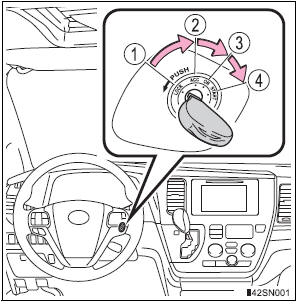Toyota Sienna 2010-2025 Owners Manual: Changing the engine switch positions

- “LOCK”
The steering wheel is locked and the key can be removed. (The key can be removed only when the shift lever is in “P”.) - “ACC”
Some electrical components such as the audio system can be used. - “ON”
All electrical components can be used. - “START”
For starting the engine.
Turning the key from “ACC” to “LOCK”

- Shift the shift lever to P.
- Push in the key and turn it to the “LOCK” position.
If the engine does not start
The engine immobilizer system may not have been deactivated. Contact your Toyota dealer.
When the steering lock cannot be released

When starting the engine, the engine switch may seem stuck in the “LOCK” position. To free it, turn the key while turning the steering wheel slightly left and right.
Key reminder function
A buzzer sounds if the driver’s door is opened while the engine switch is in the “LOCK” or “ACC” position to remind you to remove the key.
| WARNING When starting the engine Always start the engine while sitting in the driver’s seat. Do not depress the accelerator pedal while starting the engine under any circumstances. Doing so may cause an accident resulting in death or serious injury. Caution when driving Do not turn the engine switch to the “LOCK” position while driving. If, in an emergency, you must turn the engine off while the vehicle is moving, turn the engine switch only to the “ACC” position to stop the engine. An accident may result if the engine is stopped while driving. |
| NOTICE To prevent battery discharge Do not leave the engine switch in the “ACC” or “ON” position for long periods of time without the engine running. When starting the engine
|
 Starting the engine
Starting the engine
Check that the parking brake is set.
Check that the shift lever is set in P.
Firmly depress the brake pedal.
Turn the engine switch to the “START” position to start the engine.
...
 Engine (ignition) switch
(vehicles with a smart
key system)
Engine (ignition) switch
(vehicles with a smart
key system)
Performing the following operations when carrying the electronic
key on your person starts the engine or changes engine
switch modes. ...
Other materials:
System diagram
1. DISC PLAYER OUTLINE
A CD player uses a laser pickup to read digital
signals recorded on CDs. By converting the digital
signals to analog, music and other content can be
played.
CAUTION:
Do not look directly at the laser pickup because
the CD player uses an invisible laser bea ...
Camshaft Position "B" Actuator Circuit / Open
DTC P0013 Camshaft Position "B" Actuator Circuit / Open
(Bank 1)
DTC P0023 Camshaft Position "B" Actuator Circuit / Open
(Bank 2)
DESCRIPTION
The Variable Valve Timing (VVT) system includes the ECM, OCV and VVT
controller. The ECM sends a
target duty-cycle control signal ...
Diagnostic trouble code chart
1. DTC CHECK
If a malfunction code is displayed during the DTC check ,
check the suspected area listed for that code in the table
below, and proceed to the appropriate page.
DIAGNOSTIC TROUBLE CODE CHART
DTC No.
Detection Item
Suspect Area
B1244
Light Se ...
